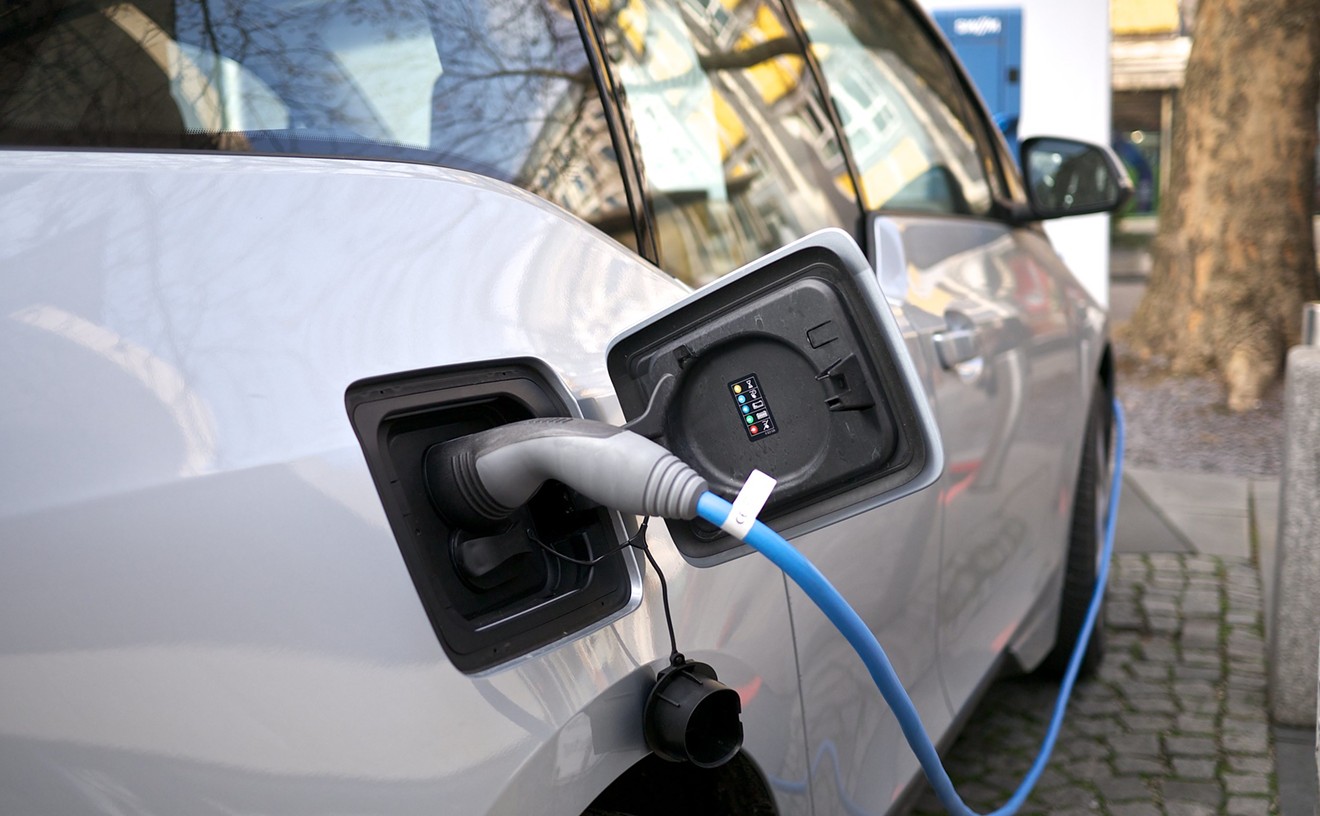When most folks think about bad behavior at Rocky Mountain National Park, they picture the likes of Casey Nocket, who recently admitted to defacing the park with her art (she typically used acrylic paint rather than chalk) and then sharing photos of her vandalism on Instagram.
But there are plenty of other people doing damage to this national treasure, either out of ignorance or de facto maliciousness — so many that the park has issued what is in essence an open letter to visitors (see it below) that urges them to tell friends who may be guilty of sins ranging from parking-lot rage to improper disposal of human waste to knock it off.
"Most of our visitors are doing everything just right," says RMNP spokeswoman Kyle Patterson. "But we're continuing to see more and more people who aren't. Truly illegal activities are increasing significantly in the park, and other things are happening that can harm the quality of visitors' experience."
One factor contributing to the escalation of these issues is popularity. In 2015, 4.1 million people visited Rocky Mountain National Park, a 21 percent increase over the previous year. The jump in attendance helped the park leapfrog Yellowstone and Yosemite to become the third most-visited national park in the country, behind only Great Smoky Mountains National Park and Grand Canyon National Park. And the boom isn't over. In 2016, Patterson says, there's been a 12 percent year-to-date increase likely attributable to reasonable gas prices, the rebounding economy and the growing number of residents living along the Front Range.
Given this influx, Patterson isn't sure if the percentage of individuals treating the park improperly is the same as it's always been but there are now simply more of them, or if the problem-causers are mainly newbies. "Some people may not have experienced a national park before," she allows. "Maybe they're more used to urban parks and they don't understand the uniqueness of a place like Rocky Mountain National Park. But there may also be a number of people who don't care."
Whatever the case, Patterson says RMNP personnel are reporting a worrisome increase in the number of "illegal escaped campfires, which is a big concern for us and a concern for the surrounding communities."
In addition, the park has noticed increasing tension in parking lots — particularly the ones along the Bear Lake Road corridor — due to the huge number of visitors, particularly during the peak hours of 10 a.m. to 3 p.m.
"Last year, especially, we were seeing a lot more belligerence — what we would call road rage or parking-lot rage," Patterson notes. "All the parking lots along the road were filling up very early in the morning; the Bear Lake lot was filling by 8:30, and the park-and-ride was filling by 10 or 10:30, which was a new thing for us. And if people didn't plan ahead, they'd arrive at the park at 11 or noon and head up the Bear Lake Road corridor and find the parking lots overfull — and when either park staff or volunteers told them they needed to keep moving because they were blocking shuttle buses trying to stay on a schedule, a number of them were like, 'I'm not moving until I find a parking space.'"
Others made their own places to park, as seen in the photo at the top of this post.
"We're having people park all four tires on native vegetation," Patterson points out. "That vegetation is very, very fragile, and as the grasses dry out and someone parks on that with a hot car, there are other dangers, too. It's happening with the tundra up on Trail Ridge Road, and it's happening along the Moraine Park Road, where people are parking and buses can't get through — so we're having to tow vehicles."
Other issues include people getting too close to wildlife because they want to be in photos with them — a potential disaster in the making, in Patterson's opinion, particularly when it comes to elk that have young calves with them.
And then there's the matter of human waste — and the incredible amount of it.
"It's truly the volume," Patterson says. "Our vault-toilet facilities at places like the Alpine Visitor Center need to be pumped out once or twice a day. That's a minimum of 5,000 gallons of waste, and that's just one location in the front country. And we also have a number of back-country privies that were mostly for overnight use by campers. But now we're seeing such a huge increase in day use that it's creating another problem, because they weren't really designed for that. The place a privy is at now, it might be the fifth or sixth iteration. You've already dug a hole here and you've restored that, and then you've dug a hole over there and you've restored that."
Other visitors don't bother with the privies — or any other toilet facilities at the park. Patterson says there have been a rising number of reports about "huge amounts of human waste on the trail, next to the trail, toilet paper strewn everywhere."
The situation would improve if people would "pack it out," in Patterson's words — and the park does provide waste bags for this purpose. Indeed, staffers have even installed a bag dispenser along a much-visited section of the Lumpy Ridge Loop, a popular climbing destination. Nevertheless, she reveals, "We've seen a big increase in human waste and toilet paper left there."
Waste-bag use has been a tough sell with visitors, Patterson acknowledges, although "we're continuing to chip away at it, to have the conversation about 'Leave no trace.'"
Other tactics have proven to be more successful. Because many visitors were simply ignoring signage letting them know that parking lots were already jammed, employees have started restricting vehicle access and turning drivers around at a kiosk on Bear Creek Road near the route to the Moraine Park campground. They're also using social media to update the parking situation. But the most effective tool has been word of mouth — getting people to tell fellow nature lovers that they need to arrive much earlier than ever before (Patterson mentions 7 a.m.) if they want a parking space in some of the more popular areas, for example.
Patterson doesn't want to leave the impression that Rocky Mountain National Park is now so overcrowded that it's impossible to commune with nature in private; solitude can still be found, she stresses, though it may take a longer hike to locate it.
In the meantime, she says, "We're really trying to get people to engage with friends who may not have experienced a national park before. The mission of the park service is providing recreational enjoyment now, but also to make sure we're preserving these unique and special places for future generations. It's about those coming behind us — so we need to work together to make sure we're leaving it a good place."
One presumably free of parking-lot rage and trails marked by human waste.
Here's the aforementioned Rocky Mountain National Park release/open letter. The bold words are in the original.
Please Help Your Friends Behave Better To Protect Rocky Mountain National Park
In 2015, Rocky Mountain National Park was the third most visited national park with over 4.1 million visitors. So far this year, Rocky is experiencing a twelve percent increase in visitation from last year. Over the last 100 years, the reasons people visit are the same: to experience nature, to seek solitude, to enjoy scenic grandeur, to watch wildlife, and to partake in outstanding recreational activities. National parks are special places for all of us and for future generations too!
Most visitors know how to behave while enjoying their national parks. Some do not. Park staff continue to see a large increase in behaviors that do not protect the park or visitor experiences. Plan to visit Rocky Mountain National Park with friends who need some tips? Here are a few of ours!
When your friends suggest you visit the park between 10 a.m. and 3 p.m., propose instead the importance of planning ahead. Coming to Rocky between 10 a.m. and 3 p.m. during the summer and fall can mean full parking lots, congested roads, busy trails, and long lines and wait times at entrance stations. This year the park has restricted vehicle access numerous times in the Bear Lake Road Corridor and Wild Basin Corridor due to congestion and full parking lots. Instead recommend hiking early or late. Check the weather forecast before you arrive at the park to better plan your day and destinations. If you plan to hike later in the day, it is critical that you know the weather forecast for the elevation of your destination. If possible, avoid weekends.
When your friends say, "Let's have a campfire," please let them know that Rocky always has fire restrictions in place: campfires are prohibited except within designated campfire rings in picnic areas and frontcountry campgrounds. Last year, the park saw a significant increase in illegal escaped campfires. In the fall of 2012, the Fern lake Fire started from an illegal campfire. That fire burned over 3,000 acres, caused evacuation of a portion of Estes Park, and cost more than 6 million dollars to suppress.
Do your friends create parking spaces where there are none? If their next door neighbor was having a garage sale would they accept customers partaking in this garage sale to park in their front yard? On their prized rose bushes? Encourage them to park in designated parking spaces in Rocky Mountain National Park. These include durable surfaces like asphalt and gravel, not on grass, meadows, bushes, or alpine tundra.
When your very close friend indicates they need to potty, first and foremost suggest an established restroom facility. If you are on a trail and a restroom facility is not nearby then leave no trace of your activity or "business." Do not step off the trail and leave your "business" for others to see, including the park's trail and wilderness crews as well as other visitors. If peeing, recommend to your friend to "drip-dry" or if toilet paper is necessary then take the toilet paper out in a baggy, backpack or pocket. If your friend is a frequent pooper, suggest taking care of that before hiking. If nature calls, plan ahead – bring a waste bag, or research tips on how to poop in the woods. Friends don't let friends go to the bathroom near water sources. Just think, you might be drinking from that water source the next day!
When your friends ask, "How close can I get to that elk, deer, bobcat, coyote, badger, bear, marmot...?" suggest they ask a different question, such as "How far should I stay back?" Let wildlife be wild and observe from a distance. Your friends might get closer to wildlife, until the wildlife reacts to their presence. When that happens, it's too late, they have reached the threshold. The elk, deer, bobcat … might leave the area because of them, affecting wildlife viewing opportunities for others. Let your friends know that approaching wildlife is illegal in Rocky Mountain National Park and it doesn't matter if they are doing it to take a photograph. There are no exceptions. Recommend investing in a good telephoto lens. Do they feel it's only a good photograph if they are in the photo with the wildlife? Suggest they take a photo of Rocky Mountain National Park's entrance sign, followed by great distant photos of wildlife. Their friends on social media will realize that they are having an adventure in a national park: being eight feet from an elk is dangerous, illegal and not necessary to demonstrate an adventuresome spirit.
When your friends ask, "Can we take our dog, cat, bunny… on park trails?" let them know pets are prohibited on ALL park trails, alpine tundra and meadows. Their leashed pet can only accompany them on established roads, parking areas, established campground and picnic areas; basically where cars can go. When they express that their dog is small and can be carried, that their dog is huge and can fend for itself, or that their dog is better behaved than your child, remind them that Rocky is wilderness. Dogs are predators that can chase, scare, and transmit diseases to wildlife. Their dog could also become prey for wildlife like coyotes, mountain lions, bobcats and Great Horned Owls. Park visitors should be able to enjoy native wildlife in their natural environment at Rocky Mountain National Park without disruption from other visitors' pets.
When your friends want to take a rock, antler, bouquet of wildflowers, chipmunk or anything else from Rocky Mountain National Park, suggest they take a photo instead and leave what they find. What if, in 2015, 4.1 million visitors took an object from the park with them?
A few extra tips: camping in Rocky Mountain National Park requires a permit; it is illegal to feed wildlife in the park, big or small, this includes chipmunks and birds; stay on existing established trails, the increase of social trails is damaging the park's incredible resources; please leave no trace, this includes taking apple cores, orange peels and everything else you and your friend brought into the park with you, along with wonderful memories of your visit!
[
{
"name": "Air - MediumRectangle - Inline Content - Mobile Display Size",
"component": "12017618",
"insertPoint": "2",
"requiredCountToDisplay": "2"
},{
"name": "Editor Picks",
"component": "17242653",
"insertPoint": "4",
"requiredCountToDisplay": "1"
},{
"name": "Inline Links",
"component": "18838239",
"insertPoint": "8th",
"startingPoint": 8,
"requiredCountToDisplay": "7",
"maxInsertions": 25
},{
"name": "Air - MediumRectangle - Combo - Inline Content",
"component": "17261320",
"insertPoint": "8th",
"startingPoint": 8,
"requiredCountToDisplay": "7",
"maxInsertions": 25
},{
"name": "Inline Links",
"component": "18838239",
"insertPoint": "8th",
"startingPoint": 12,
"requiredCountToDisplay": "11",
"maxInsertions": 25
},{
"name": "Air - Leaderboard Tower - Combo - Inline Content",
"component": "17261321",
"insertPoint": "8th",
"startingPoint": 12,
"requiredCountToDisplay": "11",
"maxInsertions": 25
}
]











